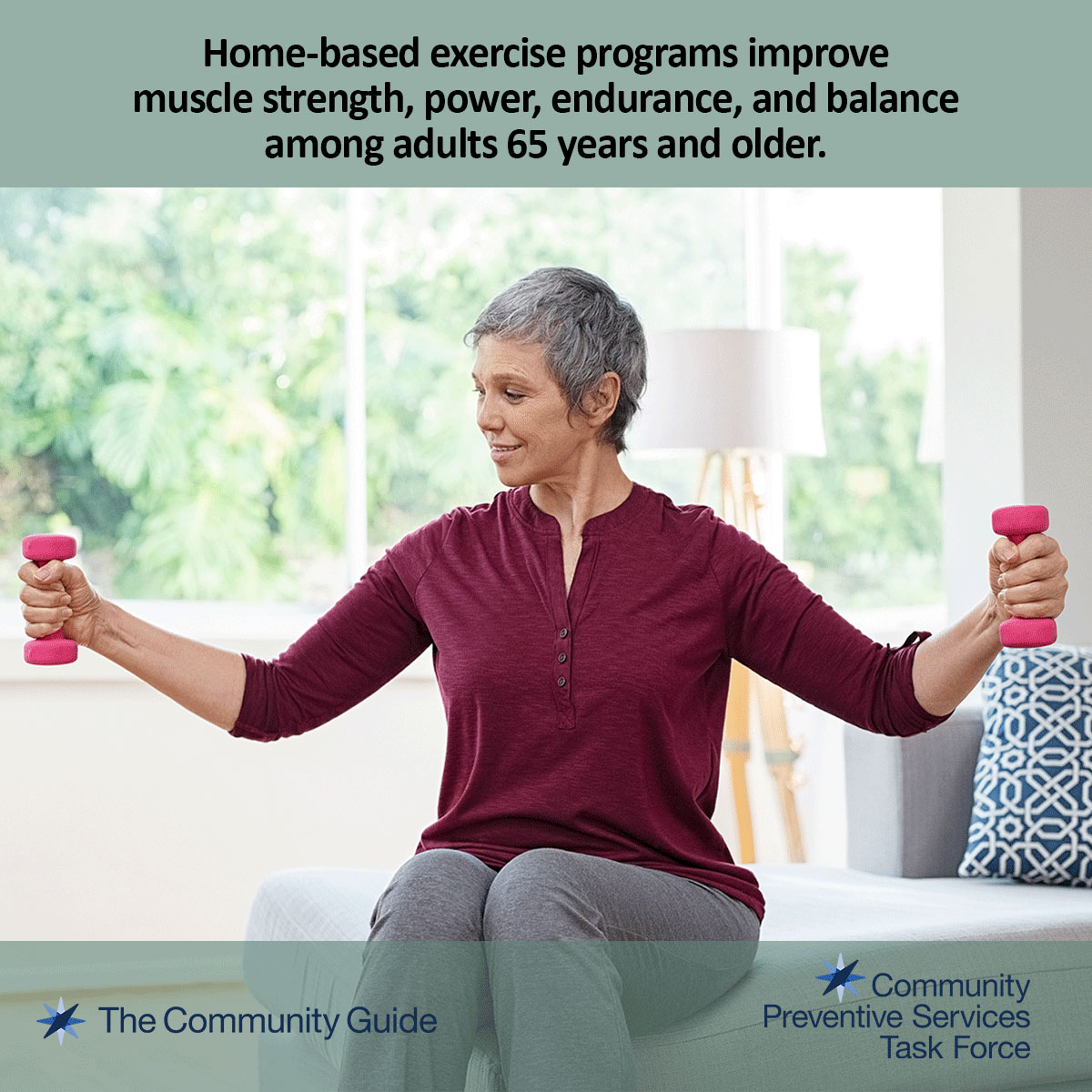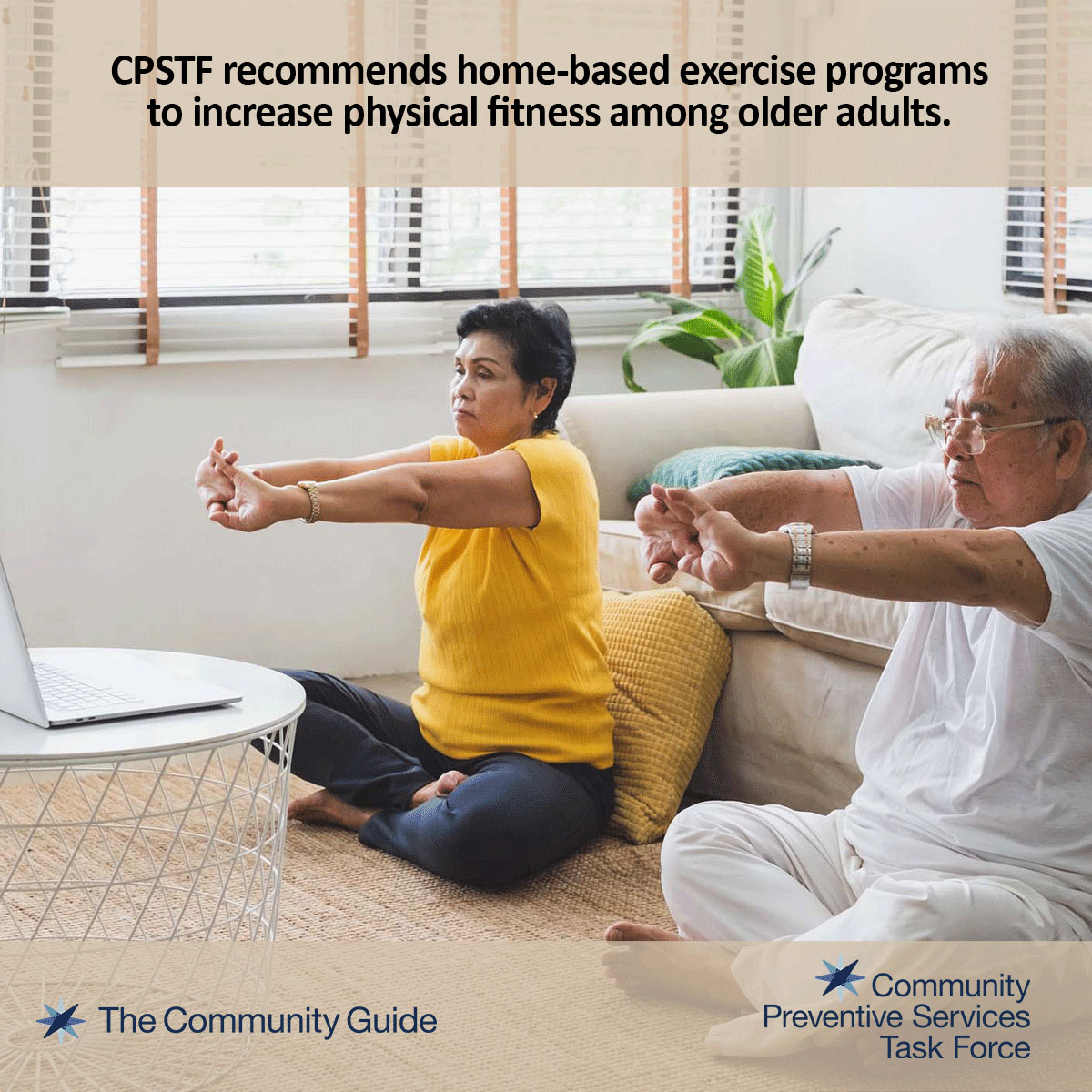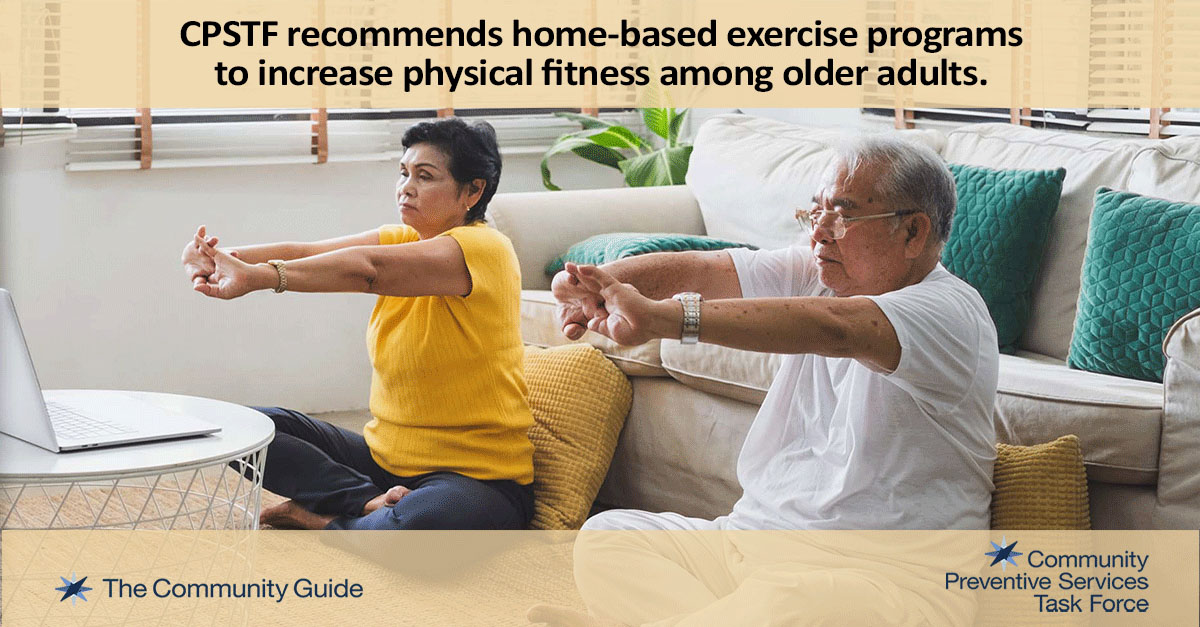Physical Activity: Home-based Exercise Interventions for Adults Aged 65 years and Older
Summary of CPSTF Finding
Intervention
Home-based exercise interventions for adults aged 65 years and older aim to instruct and motivate independent living adults to engage in regular bouts of physical activity in home settings to improve physical fitness. Interventions must include the following:
- Specific exercises, initial instruction on routines, and limited or periodic supervision
- Exercise sessions two or more times per week
- Exercises targeting improvements in strength (e.g., muscle strength, muscle power, and muscle endurance), balance, or both (i.e., multimodal)
- Low-cost equipment for exercises (e.g., hand weights, mats, towels) or exercises that make use of resources already in the home (e.g., chairs)
Interventions may do the following:
- Use physiotherapists, physical therapists, peer mentors, nurses, or trained intervention providers for training and supervision
- Provide training face to face or through educational materials or digital formats (e.g., video programs)
- Conduct monitoring and feedback using participant diaries, exercise logs, or telephone calls
- Include exercises to improve flexibility
- Encourage participants to also engage in aerobic activities such as walking
CPSTF Finding and Rationale Statement
Promotional Materials
One Pager
Graphics for Social Media



Please visit our social media messages and graphics page for full sized images and suggested social media messages.
About The Systematic Review
CPSTF uses recently published systematic reviews to conduct accelerated assessments of interventions that could provide program planners and decision-makers with additional, effective options. The following published review was selected and evaluated by a team of specialists in systematic review methods, and in physical activity research, practice, and policy.
Chaabene H, Prieske O, Herz M, et al. Home-based exercise programmes improve physical fitness of healthy older adults: a PRISMA-compliant systematic review and meta-analysis with relevance for COVID-19. Ageing Research Reviews 2021;67:101265.
The published review included 17 studies (search period through December 2020). CPSTF abstracted supplemental information about study, intervention, and population characteristics from each of the included studies.
The CPSTF finding is based on results from the published systematic review and meta-analysis, additional information from the included studies, and expert input from team members and CPSTF.
Context
Adults ages aged 65 years and older gain substantial health benefits from regular physical activity. Physical activity can preserve physical function and mobility, which may delay the onset of major disability and help older adults maintain independence longer (U.S. Department of Health and Human Services 2018). Exercises for muscle strength and balance combined with aerobic activities, such as walking, are important components of an overall weekly routine for older adults to reduce physical inactivity and maintain fitness (U.S. Department of Health and Human Services 2018).
Isolation in response to heightened risk for community-acquired infectious disease may reduce opportunities for older adults to be physically active and increase the amount of time they spend in sedentary behaviors (Ammar et al 2020). Training and supporting older adults in establishing regular exercise routines at home may help them limit physical inactivity and improve or maintain fitness during periods of time when they are advised to stay home (Chaabene et al. 2021).
Summary of Results
The published systematic review and meta-analyses included 17 studies.
- Older adults demonstrated small but statistically significant improvements in measures of physical fitness including balance (14 studies), muscle strength (10 studies), muscle power (4 studies), and muscular endurance (4 studies).
- Studies examined effectiveness of multimodal (e.g., strength and balance exercises; 11 studies) or single mode exercise interventions (strength only, 5 studies; balance only, 1 study). Single mode strength training resulted in larger effects on both muscle strength and balance than multimodal interventions.
CPSTF examined additional data reported in the included studies.
- Participants reported fewer falls and fall-related outcomes (5 studies) and more time spent engaged in physical activity overall (2 studies). Findings were mixed for self-reported improvements in quality of life (5 studies) and time spent in aerobic activities (2 studies).
- Studies found no differences in measures of mental health (2 studies).
Summary of Economic Evidence
A systematic review of economic evidence has not been conducted.
Applicability
Based on the results from the review, findings should be applicable to the general population of older adults aged 65 years and older in the United States. Additional studies are needed, however, to evaluate effectiveness of home-based exercise interventions for participants from historically disadvantaged racial and ethnic populations and populations with lower incomes.
Evidence Gaps
CPSTF identified several areas that have limited information. Additional research and evaluation could help answer the following questions and fill remaining gaps in the evidence base. (What are evidence gaps?)
CPSTF identified the following questions as priorities for research and evaluation:
- How effective are home-based exercise interventions for participants from historically disadvantaged racial and ethnic populations?
- How effective are home-based exercise interventions for participants with lower incomes?
Remaining questions for research and evaluation identified in this review include the following:
- How does effectiveness vary by age for participants aged 65 years and older?
- How do risks for exercise-associated injuries vary by age for participants aged 65 years and older?
- How does effectiveness vary for participants with physical or cognitive disabilities?
- What strategies are effective to increase recruitment of men in home-based exercise interventions?
- What are the effects of home-based exercise interventions on the following outcomes?
- Falls prevention
- Mental health outcomes
- Quality of life outcomes
- Morbidity and mortality
Study Characteristics
- Included studies were randomized trials (17 studies).
- Studies were conducted in the United States (4 studies), Japan (3 studies), and the United Kingdom (2 studies); one study each came from Canada, Denmark, Finland, Germany, Greece, Italy, Taiwan, and Iran.
- Studies recruited participants in the community (10 studies), clinical settings (6 studies), and a residential care center (1 study).
- The median age of study participants was 73 years (17 studies)
- Studies recruited both males and females, however more participants were female (67%) than male (43%).
- Interventions were delivered by physiotherapists and physical therapists (6 studies), trained intervention providers (6 studies), peer mentors (1 study), and nurses (1 study).
- Training, supervision, and monitoring included home visits (8 studies), telephone calls (9 studies), training logs or diaries (15 studies), or other types of communication (e.g., lab or clinical visits; 3 studies).
- Study interventions also reported engaging participants in walking (8 studies), flexibility exercises (4 studies), and other types of activities such as gardening (2 studies).
Analytic Framework
Effectiveness Review
- Logic Model – Effectiveness Review [PDF (Print Only) – 178 KB]
- Text Description – Effectiveness Review [PDF – 100 KB]
When starting an effectiveness review, the systematic review team develops an analytic framework. The analytic framework illustrates how the intervention approach is thought to affect public health. It guides the search for evidence and may be used to summarize the evidence collected. The analytic framework often includes intermediate outcomes, potential effect modifiers, potential harms, and potential additional benefits.
Summary Evidence Table
A summary evidence table for this Community Guide review is not available because the CPSTF finding is based on the following published systematic review:
Chaabene H, Prieske O, Herz M, et al. Home-based exercise programmes improve physical fitness of healthy older adults: a PRISMA-compliant systematic review and meta-analysis with relevance for COVID-19. Ageing Research Reviews 2021;67:101265.
Included Studies
The number of studies and publications do not always correspond (e.g., a publication may include several studies, or one study may be explained in several publications).
Effectiveness Review
Intervention Studies included in the Chaabene et al. (2021) Review
Dadgari A, Hamid TA, Hakim MN, et al. Randomized control trials on Otago exercise program (OEP) to reduce falls among elderly community dwellers in Shahroud, Iran. Iranian Red Crescent Medical Journal 2016;18(5).
Dondzila CJ, Swartz AM, Keenan KG, et al. Translating exercise interventions to an in-home setting for seniors: preliminary impact on physical activity and function. Aging Clinical and Experimental Research 2016;28(6):1227-35.
Ema R, Ohki S, Takayama H, et al. Effect of calf-raise training on rapid force production and balance ability in elderly men. Journal of Applied Physiology 2017;123(2):424-33.
Hinman MR. Comparison of two short-term balance training programs for community-dwelling older adults. Journal of Geriatric Physical Therapy 2002;25:10-6.
Hsieh TJ, Su SC, Chen CW, et al. Individualized home-based exercise and nutrition interventions improve frailty in older adults: a randomized controlled trial. International Journal of Behavioral Nutrition and Physical Activity 2019;16(1):1-5.
Iliffe S, Kendrick D, Morris R, et al. Promoting physical activity in older people in general practice: ProAct65+ cluster randomised controlled trial. British Journal of General Practice 2015;65(640):e731-8.
Kahle N, Tevald MA. Core muscle strengthening’s improvement of balance performance in community-dwelling older adults: a pilot study. Journal of Aging and Physical Activity 2014;22(1).
Kobayashi R, Nakadaira H, Ishigami K, et al. Effects of physical exercise on fall risk factors in elderly at home in intervention trial. Environmental Health and Preventive Medicine 2006;11(5):250-5.
Lacroix A, Kressig RW, Muehlbauer T, et al. Effects of a supervised versus an unsupervised combined balance and strength training program on balance and muscle power in healthy older adults: a randomized controlled trial. Gerontology 2016;62(3):275-88.
Liu‐Ambrose T, Donaldson MG, Ahamed Y, et al. Otago home‐based strength and balance retraining improves executive functioning in older fallers: a randomized controlled trial. Journal of the American Geriatrics Society 2008;56(10):1821-30.
Maruya K, Asakawa Y, Ishibashi H, et al. Effect of a simple and adherent home exercise program on the physical function of community dwelling adults sixty years of age and older with pre-sarcopenia or sarcopenia. Journal of Physical Therapy Science 2016;28(11):3183-8.
Nelson ME, Layne JE, Bernstein MJ, et al. The effects of multidimensional home-based exercise on functional performance in elderly people. Journals of Gerontology Series A: Biological Sciences and Medical Sciences 2004;59(2):M154-60.
Niemelä K, Väänänen I, Leinonen R, et al. Benefits of home-based rocking-chair exercise for physical performance in community-dwelling elderly women: a randomized controlled trial—a pilot study. Aging Clinical and Experimental Research 2011;23(4):279-87.
Perkin OJ, McGuigan PM, Stokes KA. Exercise snacking to improve muscle function in healthy older adults: a pilot study. Journal of Aging Research 2019 Oct 3:7516939.
Tsekoura M, Billis E, Tsepis E, et al. The effects of group and home-based exercise programs in elderly with sarcopenia: a randomized controlled trial. Journal of Clinical Medicine 2018;7(12):480.
Vestergaard S, Kronborg C, Puggaard L. Home-based video exercise intervention for community-dwelling frail older women: a randomized controlled trial. Aging Clinical and Experimental Research 2008;20(5):479-86.
Vitale JA, Bonato M, Borghi S, et al. Home-based resistance training for older subjects during the COVID-19 outbreak in Italy: preliminary results of a six-months RCT. International Journal of Environmental Research and Public Health 2020;17(24):9533.
Search Strategies
A search strategy for this Community Guide review is not available because the CPSTF finding is based on the following published systematic review:
Chaabene H, Prieske O, Herz M, et al. Home-based exercise programmes improve physical fitness of healthy older adults: a PRISMA-compliant systematic review and meta-analysis with relevance for COVID-19. Ageing Research Reviews 2021;67:101265.
Review References
Ammar A, Brach M, Trabelsi K, et al. Effects of COVID-19 home confinement on eating behaviour and physical activity: results of the ECLB-COVID19 International Online Survey. Nutrients 2020;12(6):1583.
Chaabene H, Prieske O, Herz M, et al. Home-based exercise programmes improve physical fitness of healthy older adults: a PRISMA-compliant systematic review and meta-analysis with relevance for COVID-19. Ageing Research Reviews 2021;67:101265.
Lindsay Smith G, Banting L, Eime R, et al. The association between social support and physical activity in older adults: a systematic review. International Journal of Behavioral Nutrition and Physical Activity 2017;14(1):56.
Parker K, Uddin R, Ridgers ND, et al. The use of digital platforms for adults’ and adolescents’ physical activity during the COVID-19 pandemic (Our Life at Home): survey study. Journal of Medical Internet Research 2021;23(2):e23389.
U.S. Department of Health and Human Services. Physical Activity Guidelines for Americans, 2nd edition. Washington, DC: U.S. Department of Health and Human Services; 2018.
Considerations for Implementation
- Physical Activity Guidelines for Americans (2nd edition) recommends multicomponent physical activities for older adults that include more than one type of activity (e.g., aerobic, muscle strengthening, balance training). Multicomponent physical activity can be done at home or in a community setting as part of a structured program that includes a combination of balance, muscle strengthening, and aerobic physical activity. Programs also may include gait, coordination, and physical function training (U.S. Department of Health and Human Services 2018).
- Chaabene et al. focused on studies that measured muscle strengthening and balance. These interventions can complement support for aerobic activities, such as walking, to achieve the recommended multicomponent approach for older adults (U.S. Department of Health and Human Services 2018).
- The following CPSTF recommendations may be used to support or complement the use of home-based exercise interventions:
- Digital technologies may enhance home-based activities by providing social contact and support typically available in face-to-face and group-based activities (Parker et al. 2021; Lindsay Smith et al. 2017).
- Several publicly available resources provide guidance on the implementation of exercise and physical activity interventions for older adults.
- CDC’s Active People, Healthy NationSM provides community-level guidance on strategies to improve physical activity and tools for action.
- The Otago program provides guidance for 17 strength and balance exercises and a walking program, designed to be performed three times a week in home settings.
- Community Healthy Activities Model Program for Seniors (CHAMPS) outlines an individually-tailored program appropriate for older adults with a range of health levels to increase physical activity.
- Active Choices includes implementation guidance for a 6-month individualized physical activity program that helps individuals incorporate preferred physical activities in their daily lives.
Crosswalks
Healthy People 2030
 Healthy People 2030 includes the following objectives related to this CPSTF recommendation.
Healthy People 2030 includes the following objectives related to this CPSTF recommendation.
- Reduce the proportion of adults who do no physical activity in their free time — PA‑01
- Increase the proportion of adults who do enough muscle-strengthening activity — PA‑04
- Increase the proportion of adults who do enough aerobic and muscle-strengthening activity — PA‑05
- Increase the proportion of older adults with physical or cognitive health problems who get physical activity — OA‑01
- Reduce fall-related deaths among older adults — IVP‑08
- Reduce the rate of emergency department visits due to falls among older adults — OA‑03